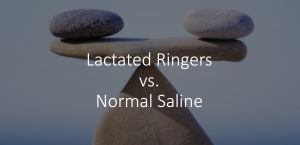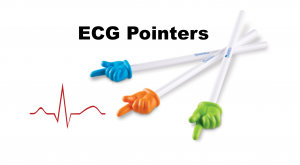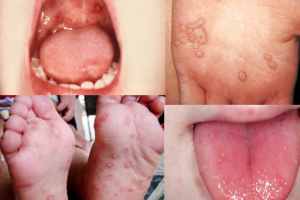Today on the emDOCs cast with Brit Long (@long_brit), we cover a difficult diagnosis: non-convulsive status epilepticus.
Episode 124: Non-Convulsive Status Epilepticus
Background:
- Status epilepticus is severe and associated with morbidity and mortality.
- Two forms: 1) convulsive SE (CSE) marked by prominent motor activity, and 2) non-convulsive SE (NCSE) without prominent or clinically obvious motor activity.
- Multiple challenges:
- NCSE is frequently missed due to the lack of overt motor signs and symptoms of seizure in the setting of other findings such as altered mental status or coma.
- There is limited agreement on the diagnostic criteria, forms of NCSE, and management.
- Currently used diagnostic measures are not 100% specific, including electroencephalogram (EEG).
Definition:
- Broad definition: status epilepticus with a change in cognitive/mental processes from baseline but no overt convulsive activity.
- Prior definitions included continuous non-convulsive seizure activity for at least 30 minutes or multiple non-convulsive seizures over a period of 30 minutes and no recovery of baseline neurologic function. Recently this definition has been modified to 10 minutes.
- Diagnosis includes electrographic abnormalities on EEG.
- The American Clinical Neurophysiology Society (ACNS) defines NCSE as seizure activity for over 10 continuous minutes or over 20% of 1 hour (12 minutes) on EEG monitoring.
- ACNS divides NCSE in the critically ill patient into electrographic status epilepticus and electroclinical status epilepticus. Definition of electrographic NCSE is based on EEG findings. Electroclinical NCSE includes a patient with clinical pattern of signs and symptoms (eye deviation, nystagmus, facial twitching) over a set period of time with EEG abnormality or EEG and clinical improvement with administration of antiseizure medication.
- Classification: non-comatose and comatose.
- Comatose associated with worse outcomes.
- Non-comatose: generalized/absence, focal/lateralization, and autonomic.
Incidence:
- Accounts for close to half of all cases of status epilepticus.
- NCSE present in up to 30% of ICU patients who are altered.
- NCSE affects 12-33% of patients after cardiac arrest and 8-35% of patients with TBI.
- Overall NCSE is associated with poor prognosis, but the underlying cause of NCSE is the major determinant of patient morbidity and mortality.
- Mortality increases with longer duration of NCSE and delays to diagnosis.
- One study found approximately half of patients who survived NCSE experienced a new neurologic deficit, while 25% returned to their baseline neurologic status. Mortality rates ranged between 15% to 52% in elderly patients in one study.
Etiologies:
- Any condition that results in supratentorial abnormalities/injury or disruption of homeostasis: epilepsy, cerebral pathology or injury, any systemic insult such as infection, and drugs or toxins.
- Most commonly associated with previously diagnosed epilepsy; up to 50% of NCSE cases are the result of inadequately treated convulsive status epilepticus or due to subtherapeutic levels of antiseizure medications secondary to drug interactions or medication non-adherence.
- Encephalitis is a significant risk factor, with 57% of patients experiencing NCSE. Hypoxic encephalopathy a frequent cause.
- Acute brain injury like stroke (15% of cases) and ICH/SAH (up to 20%) are common causes.
- Systemic injuries associated with NCSE include alcohol, toxic ingestion, metabolic derangements, infection resulting in sepsis, and autoimmune disease such as systemic lupus erythematosus.
- Medications: baclofen, busulfan, cephalosporins, cisplatin, cyclosporine, fluoroquinolones, ifosfamide, ketorolac, L-asparaginase, methotrexate, naltrexone, opioids, and tacrolimus.
Presentation:
- Many findings are subtle.
- Presentation includes negative and positive signs and symptoms.
- Negative signs and symptoms include amnesia, anorexia, aphasia, catatonia, coma/confusion, lethargy, and staring without response.
- Positive signs and symptoms include agitation, aggression, blinking, crying, delirium, delusions, echolalia, eye deviation or nystagmus, unresponsive laughter/crying, nausea and vomiting, perseveration, psychosis, and tremors.
- Most common symptom is altered or impaired mental status (80%), followed by disturbances in speech at 15%, myoclonus in 13%, change in behavior in 11%, anxiety/agitation/delirium in 8%, and extrapyramidal signs in 7%.
- Altered mental status ranges from mild confusion to coma.
- Up to 75% of patients with NCSE have no other discernable finding other than decreased responsiveness.
- Automatisms including lip smacking or subtle motor twitches in the face or extremities can be suggestive but have low specificity.
- Abnormal ocular movements or findings have a specificity approaching 86%.
- Subtle blinking or twitching of the eyelids, dilation of the pupils, gaze deviation, or nystagmus.
- One study found the combination of remote risk factors for seizure and abnormal ocular movements demonstrated a sensitivity of 100% and specificity of 55%.
- Autonomic disturbances such as hypertension, flushing, mydriasis, and diaphoresis may occur. NCSE can also present with mood disturbance, irritability, delusions, isolated fear, and paranoia.
Key Clues:
- Think NCSE in those with altered sensorium and abnormal ocular movements such as sustained eye deviation or nystagmus, automatisms such as lip smacking of subtle motor twitches in the face or extremities, and those with a history of seizures/epilepsy or a medication history with an antiepileptic.
- Concerning if there is persistent abnormal mental status or prolonged post ictal state after a convulsive seizure.
- Prolonged confusion in the setting of cerebral injury or unexplained altered mental status with no other cause are also suggestive of NCSE, as is the sudden development of isolated psychiatric symptoms but no prior history of psychiatric disease.

ED Evaluation:
- Focus is assessing for other life-threatening treatable conditions: glucose, electrolytes, ECG.
- If febrile: consider meningitis/encephalitis, perform LP for CSF.
- Imaging with CT in the ED; MRI while admitted.
- Definitive diagnosis of NCSE includes EEG based on guidelines.
- This is not possible in many EDs. We need to base the diagnosis on history, examination, and treatment response to benzodiazepines/other antiepileptics.
- Newer devices allowing for rapid EEG have been developed for use in the ED setting, but these require further validation prior to widespread adoption.
- EEG recommended in patients with fluctuating or unexplained change in behavior or mental status, acute cerebral pathology with altered mental status, persistent change in mental status after treatment of convulsive seizures, critically ill patients who are altered, recent seizure without return to patient baseline from postictal state after 1-2 hours, patient intubated for seizures, and coma after hypoxic brain injury.
- Electrographic NCSE diagnostic criteria incorporate EEG findings. There are two forms of EEG: routine and continuous.
- Continuous EEG is more commonly used in the ICU setting and is recommended for patients who fail to return to baseline function after treatment with antiepileptics and for those with unexplained altered mental status or coma.
- Continuous EEG may be better able to detect discharges compared to repeated routine EEG with higher sensitivity, but no reduction in mortality with continuous versus routine EEG. A significant proportion of patients require over 24 hours of monitoring to definitively diagnose seizures.

Management:
- Treat life-threatening conditions first.
- Treat seizures: benzodiazepines are the recommended first-line treatment. IV, oral, IO, or IM (whichever route is fastest).
- Benzodiazepine administration can be diagnostic if patient improves.
- Load with another agent as well: Fosphenytoin 20 phenytoin equivalent units/kg, valproate 40 mg/kg, or levetiracetam 60 mg/kg IV.
- (ESETT) Established Status Epilepticus Treatment Trial found that each of these agents stopped seizure activity and led to improved mental status in close to half of patients, with similar adverse events.
- Have low threshold for airway protection and endotracheal intubation with sedation, especially if seizure activity is suspected and no improvement with benzodiazepines.
- Induction agent: ketamine, propofol, or midazolam
- Use succinylcholine if possible.
- After intubation, need continuous EEG.
- Summary: There are few data data regarding optimal treatment of NCSE, and rapid seizure termination remains the primary goal.
- Current recommendations based on poor quality evidence recommend administering first and second line antiseizure medications in patients who are comatose and assessing for response.
- If these medications do not control seizures or the patient does not demonstrate an improvement in mental status, intubation with a sedative such as propofol or ketamine and paralytic are recommended.
Mimics:
- Many mimics; focus on three: postictal state, toxic/metabolic encephalopathy, catatonia.
- Postictal state may occur for days in patients with cerebral injury, but EEG will demonstrate slowing or suppression, while in NCSE, there will be epileptiform discharges.
- Toxic and metabolic encephalopathy can present with severe alterations in mental status, but patients will present with asynchronous and multifocal myoclonic movements, compared to the synchronous movements of NCSE. EEG will also demonstrate slowing with encephalopathy.
- Catatonia and NCSE are difficult to differentiate. NCSE may cause catatonia. Both conditions improve with benzodiazepines, and thus EEG and clinical evaluation are necessary to differentiate the conditions. EEG may demonstrate diffuse slowing in catatonia, but in NCSE the EEG will demonstrate epileptiform discharges or frequent or continuous generalized spike-wave discharges.
Summary:
- NCSE is a condition associated with prolonged seizure activity and the absence of overt motor activity.
- It is underdiagnosed due to its variety of nonspecific signs and symptoms.
- There are multiple causes including epilepsy, cerebral pathology or injury, any systemic insult such as infection, and drugs or toxins.
- The most common presentation is altered mental status, but other signs and symptoms include abnormal ocular movements and automatisms such as lip smacking of subtle motor twitches in the face or extremities.
- EEG is recommended, but this disease should be considered in patients with prolonged postictal state after a seizure with no improvement in mental status, altered mental status with acute cerebral pathology (e.g., stroke, hypoxic brain injury), and unexplained altered mental status.
- Management includes treating life-threatening conditions and cessation of the seizure activity with benzodiazepines and other antiseizure medications.
References:
- Trinka E, Cock H, Hesdorffer D, et al. A definition and classification of status epilepticus–Report of the ILAE Task Force on Classification of Status Epilepticus. Epilepsia. 2015 Oct;56(10):1515-23.
- Long B, Koyfman A. Nonconvulsive Status Epilepticus: A Review for Emergency Clinicians. J Emerg Med. 2023 Oct;65(4):e259-e271.
- Wang X, Yang F, Chen B, Jiang W. Non-convulsive seizures and non-convulsive status epilepticus in neuro-intensive care unit. Acta Neurol Scand. 2022 Dec;146(6):752-760.
- Young GB, Jordan KG, Doig GS. An assessment of nonconvulsive seizures in the intensive care unit using continuous EEG monitoring: an investigation of variables associated with mortality. Neurology. 1996;47:83-89.
- Meierkord H, Holtkamp M. Non-convulsive status epilepticus in adults: clinical forms and treatment. Lancet Neurol. 2007;6:329-339.
- Drislane FW. Presentation, evaluation, and treatment of nonconvulsive status epilepticus. Epilepsy Behav. 2000;1:301-314.
- Baker AM, Yasavolian MA, Arandi NR. Nonconvulsive status epilepticus: overlooked and undertreated. Emerg Med Pract. 2019 Oct;21(10):1-24.
- Shneker BF, Fountain NB. Assessment of acute morbidity and mortality in nonconvulsive status epilepticus. Neurology. 2003;61(8):1066-1073.
- Kaplan PW. Nonconvulsive status epilepticus in the emergency room. Epilepsia. 1996;37(7):643-650.
- Ziai WC, Schlattman D, Llinas R, et al. Emergent EEG in the emergency department in patients with altered mental states. Clin Neurophysiol. 2012;123(5):910-917.
- Abdel Baki SG, Omurtag A, Fenton AA, et al. The new wave: time to bring EEG to the emergency department. Int J Emerg Med. 2011;4:36.
- Roodsari GS, Chari G, Mera B, et al. Can patients with non-convulsive seizure be identified in the emergency department? World J Emerg Med. 2017;8(3):190-194.
- Maganti R, Gerber P, Drees C, Chung S. Nonconvulsive status epilepticus. Epilepsy Behav. 2008;12:572-586.
- Sutter R, Semmlack S, Kaplan PW. Nonconvulsive status epilepticus in adults -insights into the invisible. Nat Rev Neurol. 2016;12:281-293.
- Trinka E, Leitinger M. Which EEG patterns in coma are nonconvulsive status epilepticus? Epilepsy Behav. 2015;49:203-222.
- Hirsch LJ, Fong MWK, Leitinger M, et al. American Clinical Neurophysiology Society’s Standardized Critical Care EEG Terminology: 2021 Version. J Clin Neurophysiol. 2021 Jan 1;38(1):1-29.
- Fernandez-Torre JL, Kaplan PW, Hernandez-Hernandez MA. New understanding of nonconvulsive status epilepticus in adults: treatments and challenges. Expert Rev Neurother. 2015;15:1455-1473.
- Rudin D, Grize L, Schindler C, et al. High prevalence of nonconvulsive and subtle status epilepticus in an ICU of a tertiary care center: a three-year observational cohort study. Epilepsy Res. 2011;96:140-150.
- Laccheo I, Sonmezturk H, Bhatt AB, et al. Non-convulsive status epilepticus and non-convulsive seizures in neurological ICU patients. Neurocrit Care. 2015;22:202-211.
- Zehtabchi S, Abdel Baki SG, Malhotra S, Grant AC. Nonconvulsive seizures in patients presenting with altered mental status: an evidence-based review. Epilepsy Behav. 2011;22:139-143.






